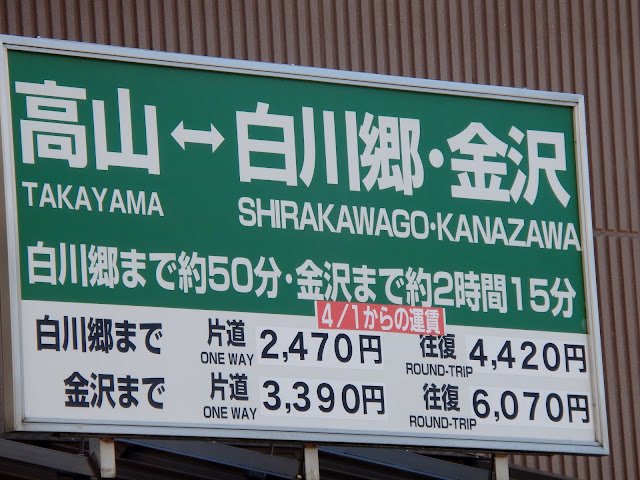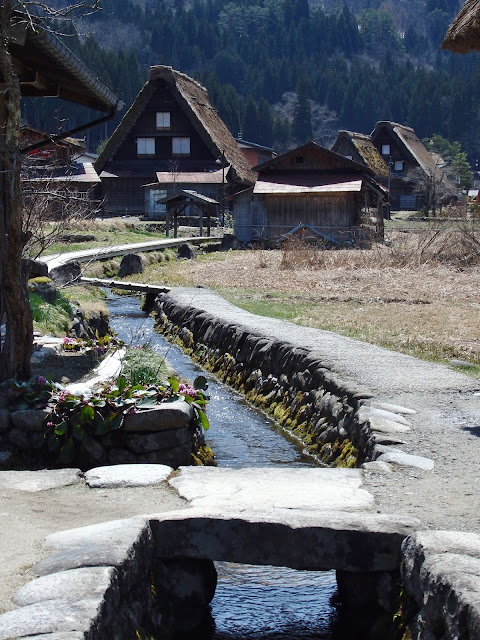There are always a million opportunities when you are traveling. Stay on track or wander a little? Design a schedule to see everything you think you want to see, while you're sitting in the comfort of your American home with all it's luxuries; or leave some wiggle room to chase those "yet unknowns" that pop up once you're there, and you're immersed in the culture of the present?
We land somewhere in the middle. We structure our visit to include the "must do's", and schedule plenty of time for that. Plus we add a little room for adventure, the chance to wander off (or run off!) to see something that we were previously unaware of.
Shirakawa-go (Sheer-a-cow-a-go) is one of those in the latter category. It's a really unique little village in Japan, between our (scheduled) stops @ Takayama and Kanazawa. It's off the beaten trail, not exactly a day trip, but certainly not worth an overnight stay.
So of course there's an adventure associated with getting there. We traveled by train from to Takayama, and noticed upon disembarking that the bus and train depot are one-in-the-same. How handy for us!
Because we need to take the bus to Shirakawa-go. And we can't stay there, even if we were inclined to, 'cause we already have a hotel booked @ our next destination. So we need to be sure that we can get from here to there, but also, once there, to our hotel, clear over yonder.
We are staying just a block away, so we roll our luggage down to the station ahead of schedule, to buy a ticket (in a foreign language) and find the right bus (in a foreign language) with lots of other people (who are also speaking a foreign language).
It's odd that, as we are boarding,there's a local actually counting us as we get on the bus. They mystery doesn't last long, though. Once all the seats are full, people keep getting on board -- and they fold down a special "isle seat", all the way from the back of the bus to the front of the bus. I must say, I've never seen the like. This is decidedly different than back home in the US of A. And I won't deny feeling just a little claustrophobic about this whole deal........
Arriving at Shirakawa-go, we grab our luggage from the underneath storage of the bus, and sprint to the lockers that we read are available for that purpose.
They seemed to be both limited and, subsequently,
in great demand, so we were grateful that we weren't stuck hauling them around for the remainder of the day -- kudos, once again, to Mr. C and his research.
And from there, it's a step back in time.
Back to the 11th century, to be precise.
This village still builds and lives in the thatched roof houses of yesteryear. The houses are constructed in an architectural style known as "gassho-zuriki" (合掌造り)
interpreted as "prayer-hands construction", and is characterized by a thatched and steeply slanting roof that resembles two hands in posed in prayer. The design is exceptionally strong and, combined with the unique properties of the roof's thatching, allows these houses to withstand and shed the heavy weight of the regions notoriously deep snowfalls in wintertime.
Me? I just think they're adorable.
But I'm very glad that we are "very glad welcome" ; especially if you "be on one's right".

We think this must be a "Ryokan" ~ judging from the laundry on the line. Which means that you could stay overnight here, if you want to get the full experience, in the traditional Japanese style. I think it's a lovely village to visit, but......I'm still unsure about the plumbing situation, so color me hesitant.....

So the big deal is this: It's not the lifestyle, or the remote mountainside existence. The big deal is the houses, and how they're constructed. From the land, from the earth, from materials-at-hand to withstand these mountain winters, and unique in all the world.
The houses face north and south, to minimize wind resistance They stand in a specific direction to adjust the amount of sun in order to keep the room cool in the summer and warm in the winter.
Well, I would say cool(er) and warm(er). 'Cause while the roofs might be thick and cozy, remember that the walls are still (mostly) paper thin. As in actual paper. My feet were freezing just having to kick off our shoes to tour these places. Icicles. You all know that I do better in flip-flops.
While most still live their day-to-day lives like this, on Tatami mats, with a fire in the hearth there are some who graciously open their homes to visitors like us, in order to see and fully appreciate why, to preserve this, is so wonderful.
We enter the house, and then climb from floor-to-floor (normally at least three floors) on ladders like this.

While the lower levels of the house(s) were meant for the family to live, the upper level(s) were meant for storage and industry. Sericulture. The silkworm industry, to be exact. Yup. Because there's an abundance of Mulberry trees, and thus Mulberry leaves here, this industry thrived in this remote and harsh region. It seems that silkworm larvae love to feed on Mulberry leaves. Who knew??? So most every home raised them in their attics, and harvested their wonderful silk to sell.

You really must look at how the beams are cast. Huge logs are set and bound with ?? Ropes and ?? There are no nails or spikes.
It's for sure not how we would do it in the US.
Me & Mr. Construction C are spell bound by all this.
I may not know know what it all means,
but I appreciate the beauty of it.
but I appreciate the beauty of it.
It's cold. Cold enough for an igloo.
Cold enough for "Igloo gloves" jokes.
I'm assuming that this is supposed to be funny.
I'm assuming that this is supposed to be funny.
Here they are drying the sheaths
that will become the thatched roofs of the future.
It's so picturesque.
These thatched roofs are a marvel, and are unique to this type of architecture, which is unique to Japan. At the time of re-thatching (basically, it's re-roofing), all the old sheaths are first stripped from the roof. They are sorted, and those that can be are re-used.
Then, teams of men boost the new sheaths up to those on the roof, who pass them up and up and up; and the entire roof is re-covered. And then they repeat this step. And then they repeat it again.
It's not complete until 5 layers of thatching are laid, and the peak is covered and interwoven with the roof. No matter what the weather, no matter if it's rain or shine, the entire process must be (and is) completed within a single day. The entire village turns out for this, even the neighboring people will come volunteer their time; Indeed, is expected to, because (of course) when it's your turn you're gonna' want the same. It reminds me very much of our Amish barn-raisings, yes? There's a term for it, in Japanese it's called YUI.
I read some fascinating information while we were on-site, about how many men it takes (it's a lot), what the cost equates to in current times (it's astronomical); but try as I might I've not been able to find all the same facts on-line.
Finally, it's time for a little lunch. We've learned that one of the "safest" things to order in Japan is an Udon noodle bowl. Soba noodles in an excellent, rich broth, sometimes with pork or beef or chicken; sometimes with veggies; sometimes with mystery ingredients to us Westerners.
This one was excellent.
(I like that the "amazake" is served "onky in winter".)
This tame lunch seems all the more special once we saw our neighboring Japanese diners being served something else. Something that was alive. Insects??? Something with wings. Lots and lots of wings. That were beating furtively against the heat of ??? whatever they were being served upon, that was (evidently) hot enough to silence those beating wings, after a bit. Wish I'd caught a video clip. But, sometimes, it's just awkward to explain why you would be videoing somebody else's lunch.
Even if it is still alive and trying to escape. Yikes.
It's time for us to catch our bus to our next destination.
What a lovely little town, what a fascinating stroll back through time. There's always the debate, with these little gems, that we (meaning the tourists) just ruin it by coming to visit. I don't know, perhaps we do. But at the same time, I do so appreciate those that open their hearts and homes and lifestyles to those of us who are interested in learning about their life and their culture.
I know I would, were the sandal on the other foot.





























Wow! Very cool! The extent of my travels to Japan only include a mad dash through customs to find sushi, make a video, & gather a receipt to prove I actually had sushi in Japan! LOL! (Well, then there was the mad dash to catch out flight home) I'll return for a much longer visit someday!
ReplyDeleteFabulous photos, such an interesting article and your writing style captures me and leaves me wanting the article to be just a little bit longer! Thank you!
ReplyDeleteI can't think of a nicer compliment to give an author, any author, than, "you leave me wanting more". We have seen and done some interesting and educational things in all our travels -- I only write about what I find fascinating -- which is most of what I see and do when I'm in a foreign country. Thank you in return.
ReplyDeleteThis blog article has so many amazing pictures in it. So much time spent to share this with everyone. Those of us who may not have opportunity to travel here are guided along on this article!
ReplyDeleteI love the detail. I guess I always thought the community barn raising joint efforts were specific to our pioneer settlers. How wrong I was! The world becomes smaller when we see other countries did things just like us.
Thank you for showing the world to us through your adventures. I think a travel show should be in your future!!!'